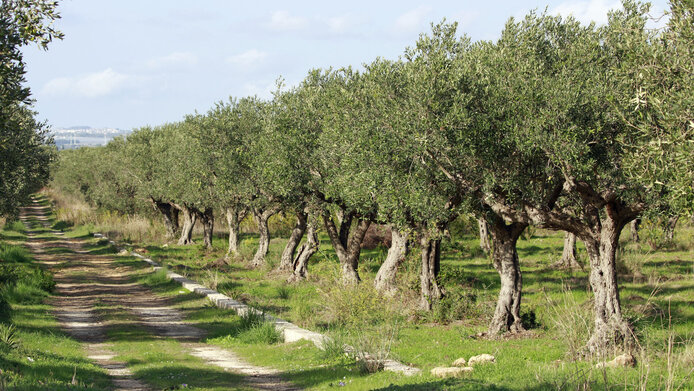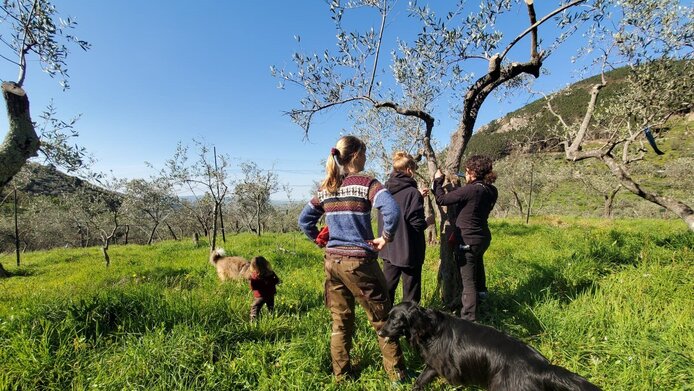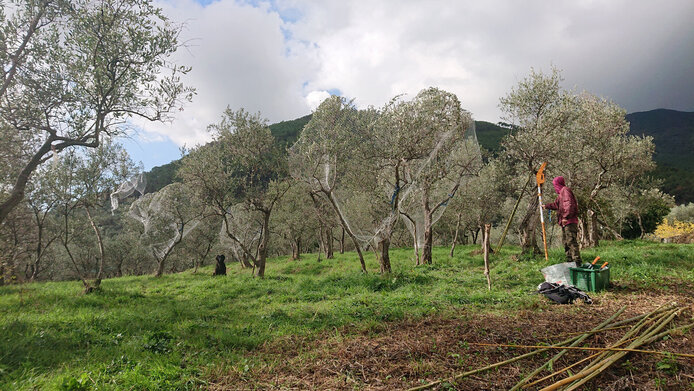Good neighbors for healthy olive groves

In recent years, the price of olive oil has surged far beyond inflation levels. This is caused by output slumps, which are strongly linked to climate change manifested by extreme weather events and agricultural pests. The unique ecosystems of the traditional cultivation areas in the Mediterranean region, some of which have been farmed for thousands of years, seem to have gone off kilter. They have reached a point where it makes sense, for economic reasons alone, to revert to more sustainable land use.
In this context, one of the most important objectives is to return to a high level of biodiversity, which makes the crops more resilient. Agroecologist Bea Maas is exploring how more biodiversity can be achieved in a targeted manner and what the benefits would be for olive cultivation. Funded by the Austrian Science Fund FWF, her “ECO-OLIVES” project focuses on olive crops in Tuscany. “Together with local and international partners, we are developing tools that make it easier for olive farmers to work towards sustainable use of their farms on a scientific basis,” says Maas.
“The Mediterranean region is blessed with a unique biodiversity, and it is particularly sensitive, both to global warming and to changes in land use,” explains Maas. “Small-scale agricultural enterprises, where the connections between different habitats are preserved, also do much better than large-scale monocultures in preserving the associated benefits of the ecosystem, such as natural pest control.” Since a land use concept based on this principle must also lend itself to practical implementation, the project team is accordingly developing measures together with local farmers.
More information
Olive groves as “agroforestry systems”
In contrast to sparse monocultures, olive groves can also be cultivated in the shape of so-called “agroforestry systems”, which provide a home also for many other plants and animals. “Agroforestry systems can significantly increase the potential for sustainable agriculture. The aim is to make the ecosystems as diverse as possible and to harness their potential in the best possible way.” For this purpose, the researchers are investigating cultivation on a total of twelve carefully selected olive groves in Tuscany, spread over an area of 30 square kilometers. These twelve olive groves differ in their respective surrounding areas, which feature varying degrees of adjacent seminatural habitats – including abandoned agroforests and other fallow land, hedges, bodies of water or forests. On each of these farms, the researchers monitor a handful of olive trees representative of the site.
In their analysis of the respective areas’ biodiversity, Maas and her colleagues focus on model organisms such as birds, bats, spiders and insects, which are particularly sensitive to changes in land use. The researchers monitor how the presence of different species over the course of the year affects the health and yield of the trees under study. “Seasonal effects, i.e. whether different animal groups are present in spring or fall and what impact they have, are at the center of attention” explains Maas. “On the other hand, we also shrouded individual trees with nets so as to simulate the absence of bats and birds for comparative purposes.”
At the same time, the team conducted field experiments of agricultural management. “Even small modifications to current practices can contribute to conserving biodiversity. Tree pruning is one important aspect, for example, which farmers often do following traditional, non-systematic practices. We are working on optimizing the timing and technique of pruning on a scientific basis,” notes Maas. “In this way one can not only maximize olive production, but also improve tree resilience – by making them better accessible to birds and bats that feed on pests, for instance.” The newly developed standards will then be communicated to local and international farming communities.
Trees, hedges, fallow land
Maas is convinced that the initial project data on the biodiversity of the areas studied underline the importance for yield and biodiversity of semi-natural habitats in the vicinity. “The richer the structure of a nearby environment, the more conducive it is for sustainable olive production. Trees, hedges and fallow land near olive groves have a positive effect on the diversity of species and what they do for the ecosystem,” explains Maas. “Not only does the number of species increase, but also the number of individuals per species.” And species that occur in large numbers are particularly relevant for the ecosystem. Maas: “Swifts, which are widespread in Europe, are a classic example. Due to climate change, the migratory behavior of these birds is changing. Sometimes their arrival is out of sync with the time when their food is most available.”
The migratory behavior of these animals is changing due to climate change. In the context of the project, the team now intends to develop an application that provides farmers with guidance on the ecological environment of their cultivated areas based on local data. “The app analyzes satellite images for beneficial habitats in the vicinity of the olive tree grove, such as the presence of hedges or other tree species, in order to assess the ecological potential of a site,” explains Maas. The cultivation areas are divided into three categories according to their potential. Users receive suggestions on how to improve the situation or at least prevent it from deteriorating. With every new green strip sporting herbs and every newly planted hedge, a small piece of biodiversity is brought back to the millennia-old cultivated areas.
Personal details
Bea Maas is an agroecologist and nature conservation researcher committed to biodiversity and sustainable development in land use. She works at the University of Vienna and the University of Sant'Anna in Pisa and coordinates international projects to establish innovative management strategies for agricultural regions. The research project ECO-OLIVES (“Ecological Management of European Olive Agroforests”, 2022-2024) received EUR 240,000 in funding from the Austrian Science Fund FWF under its Elise Richter Program.
Publications
Maas B., Ocampo-Ariza C., Whelan C. J.: Cross-disciplinary approaches for better research: The case of birds and bats, in: Basic and Applied Ecology 2021
Maas B., Fabian Y., Kross S. M., Richter A.: Divergent farmer and scientist perceptions of agricultural biodiversity, ecosystem services and decision-making, in: Biological Conservation 2021







